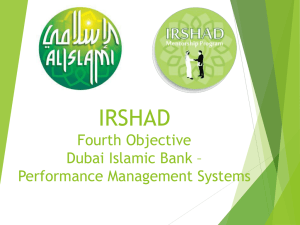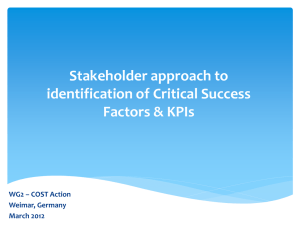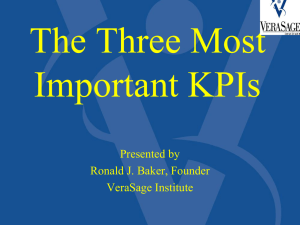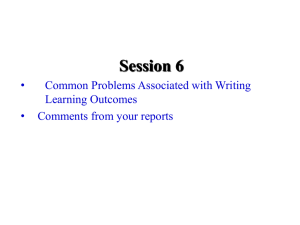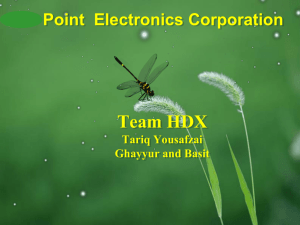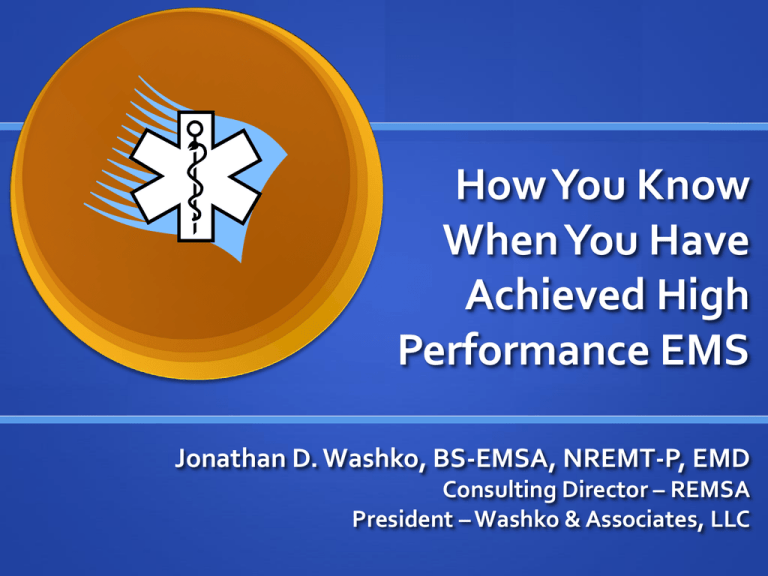
How You Know
When You Have
Achieved High
Performance EMS
Jonathan D. Washko, BS-EMSA, NREMT-P, EMD
Consulting Director – REMSA
President – Washko & Associates, LLC
Presentation Overview
Why Should You Care
Define HPEMS
Building The Foundation - Data
Key Performance Indicators
Trending
Benchmarking
Leveraging Technology for Success
Achievement of HPEMS
About the Presenter
Involved in Public Safety for 25
years
BS Degree in EMS Admin with
focused studies on EMS system
design and adult education
Studied under Jack Stout,
father of SSM/HPEMS
Held Paramedic to Executive
level positions with small,
medium and large sized
companies
Have worked in / for every type
of EMS system design
10 Years with AMR as corporate
executive and systems
troubleshooter
Co-founder / co-developer of
FirstWatch
20 years EMS system design
consulting experience
Have experienced the good and
bad of >100 EMS agencies
around the globe
Currently Director with REMSA,
Reno, NV
About REMSA/SEMSA
Based in Reno, NV
Subsidiary sites in Susanville
& Merced, CA
A Public Utility Model EMS
System
Services Offered
Ground ALS
Rotor Wing
Wheelchair
Special Event
Training Academy
Approximately 50,000 calls
annually
Triple Accredited agency
ACE
CAAS
CAMTS
No Tax Subsidy
REMSA’s Military Support
REMSA was a 2008 Recipient of the Freedom Award
Currently have 5 Medics that just recently returned from
active duty in Afghanistan
Support our troops in various ways
Keep REMSA Salary whole while on Active Duty
Provide 100% Benefits coverage while on Active Duty Including
Family
Send along laptops, software & other needed items
Send monthly care packages to our employees
Achieving HPEMS:
Why Should You Care
If you desire…
Quality
Efficiency
Effectiveness
Reliability
Accountability
Sustainability
Profitability
…then you want to achieve HPEMS
“High Performance EMS Systems”
A preface written by Jack L. Stout
(Father of System Status Management
and the Public Utility Model EMS
Concept)
Included in the American Ambulance
Association’s Community Guide to
Ensure High-Performance Emergency
Ambulance Service
Achieving HPEMS:
“As EMS providers, we invite the public to literally trust us with their lives. We advise
the public that, during a medical emergency, they should rely upon our organization,
and not any other. We even suggest that it is safer to count on us, than the resources
of one’s own family and friends. We had better be right.
Regardless of actual performance, EMS organizations do not differ significantly in
their claimed goals and values. Public and private, nearly all claim dedication to
patient care. Efficient or not, most claim an intent to give the community its money’s
worth. And whether the money comes from user fees or local tax sources, the claim
is the same—the best patient care for the dollars available. It’s almost never true.
Our moral obligation to pursue clinical and response time improvement is widely
accepted. But our related obligation to pursue economic efficiency is poorly
understood. Many believe these are separate issues. They are not. Economic
efficiency is nothing more than the ability to convert dollars into service. If we could
do better with the dollars we have available, but we don’t, the responsibility must be
ours. In EMS, that responsibility is enormous—it is impossible to waste dollars
without also wasting lives.”
Jack L. Stout
HPEMS Success Triad
• Constant Balancing of:
– Patient Care
• Response Times
• Clinical & Service Quality
• Customer Service
– Economic Stability
• Profitability
• System Stability
– Employee Wellbeing
• Morale
• Retention
• Health, Safety & Welfare
The
EMS
Success
Triad
Employee Wellbeing
Achieving HPEMS: Definition
Employee Well-being / Satisfaction
HPEMS / SSM
Productivity / Unit Hour Utilization / Profitability
Station Based EMS
Union Formation Zone
Performance
Improvement
Zone
Performance Comfort Theshold
CONTRACTUAL DANGER ZONE
UHU Syndrome
Response Time Goal
Triad Homeostasis
Response Time Reliability / Performance
Unit Hour Reduction Zone
The Triad Tradeoff
Geospatial / Unit Hour Deployment Plan
Least Aggressive
Most Aggressive
Best Care
Best Profit
HPEMS System Operational Maturity
Young
Middle Aged
Patient Care
Mature
Copyright 2006 by Washko & Associates, LLC - All Rights Reserved
So What is HPEMS?
The ability to convert dollars into superior
service with as little waste as possible via a
balanced modus operandi
Achieving HPEMS: The
Foundation
Data…Data…Data
“If you can’t measure it, you can’t manage it”
Klark Staffan
REMSA VP
Achieving HPEMS: The
Foundation
Data….Data…Data
Not just any data, but ACCURATE data
The basic building blocks that all of the
concepts used in HPEMS are founded
on
Bad data is like bad concrete, you can
build with it but it will crumble under a
load
Your business processes (or lack there
of) drive how data is collected and
therefore yield consistent or
inconsistent data as end results of
these processes
Achieving HPEMS: The
Foundation
Common Examples of Bad Data Processes in HPEMS
NET requested P/U time vs. promised time
Lack of auditable data reconciliation and error correction
process
Time stamp corrections
Geocoding failures
Response zone errors
Changing data to meet measurement criteria vs. properly
designed reporting systems
Response times
Accurate measurement of LDT calls
Ability to track various types of Unit Hours
Scheduled, Actual, Lost & Effective
Achieving HPEMS: The
Foundation
Common Examples of Bad Data
Processes In HPEMS Continued…
Inability to access / report on data
Bad CAD or Technology
Un/consciously Incompetent
General lack of data centric focus by
organization
Lack of personnel with necessary skill
sets
Misunderstanding of HPEMS theory and
practices
Achieving HPEMS: The
Foundation
Why is Data Accuracy Important?
It’s the basis for your Deployment Plan
Temporal Demand Analysis => Schedule
Primary Efficiency Platform for HPEMS
Yields right number of resources at the right time based on
consumer demands and service reliability goals
Geographic Demand Analysis => Post Plan
Primary Effectiveness Platform for HPEMS
Yields proper placement of resources at the right time based on
consumer demands and service reliability goals
Achieving HPEMS: The
Foundation
Importance of Data Accuracy Continued….
Foundation for development of Key Performance Indicators
(KPIs)
Foundation for internal and external benchmarking and
trending
Foundation for HPEMS budgeting
Foundation for pro forma modeling in RFPs and agency
acquisitions
Mechanism to ensure highest ROI if selling your organization
Achieving HPEMS:
Key Performance Indicators KPIs
Define KPIs
Types / Classes of KPIs
Design elements
Tying KPI’s to strategic goals
Examples of common
HPEMS KPIs
KPIs role in achieving HPEMS
Key Performance Indicators (KPIs)
Definition
“A key performance indicator (KPI) is a measure of
performance. Such measures are commonly used to
help an organization define and evaluate how
successful it is, typically in terms of making progress
towards its long-term organizational goals. KPIs can
be specified by answering the question, "What is
really important to different stakeholders?" KPIs
may be monitored using Business Intelligence
techniques to assess the present state of the
business and to assist in prescribing a course of
action. “
Key Performance Indicators (KPIs)
Definition
KPIs = An Organizational “GPS” system
Provides users with an ability to set an end goal destination
(waypoint – where you want to go)
Shows where you’ve been (breadcrumb trail/ tracks)
Provides directional guidance (navigation) to a waypoint
(desired end)
Compass / Baring of route to travel
Distance / ETA to waypoint
Key Performance Indicators (KPIs)
Types / Classes
HPEMS KPI Categories
Operational KPI’s
Measures variables related to operating metrics
Sets the path (waypoints) and how to navigate
Goal achievement implementation variables
Qualitative KPI’s
Measures variables related to end user quality and satisfaction
Measures the end user effects of paths taken
Financial KPI’s
Measures variables related to economic metrics
Measures the results of the paths taken
Key Performance Indicators (KPIs)
Design Elements
Elements of successful KPIs:
Measurable with reasonable effort
Accurate
Is relative to achieving the topic / goal
Operational
Qualitative
Financial
Achievement timeframe for goal
Key Performance Indicators (KPIs)
KPIs & Strategic Goals
“If you can’t measure it, you can’t manage it”
Aligning KPIs with strategic goals is key to helping achieve
these goals
Performance feedback system / system situation indicator
(gauges of progress)
Allows setting of the “way points” and “baring / path” to those
way points
Without this approach, achieving any desired goal can be VERY
challenging if at all possible
Key Performance Indicators
HPEMS Example
Example of HPEMS KPIs and how they tie to strategic goals…
Strategic Goal:
Protect my EMS market rights through improving
on these 6 factors of EMS quality in the most
efficient and effective means possible
Response Time Reliability
Customer Service
Staff Professionalism
Vehicle cleanliness / organization
Vehicle comfort / ride
Clinical sophistication & improved patient outcomes
Key Performance Indicators
HPEMS Example
Response Time Reliability
Operational KPI’s
Fractile measurement of Response Time
reliability
Emergency
Non-emergency
Inter-facility
Actual Unit Hour Utilization (AUHU)
Effective Unit Hour Utilization (EUHU)
Accounts for Lost Unit Hour Management (LUH)
Root cause matrix for system failures
Key Performance Indicators
HPEMS Example
Response Time Reliability Continued…
Qualitative KPI’s
VF ROSC Cardiac Arrest Survival Rate
GCS Delta (Initial / At Destination)
SAO2 Delta (Initial / At Destination)
Customer satisfaction quotient on timeliness
Employee satisfaction quotient
Key Performance Indicator
HPEMS Example
Response Time Reliability Continued…
Financial KPIs
Labor Cost Variances
Transport Volumes
A/R Measures
Maintenance Costs
Fuel Costs
EBIT / Fund Balance Variances
Key Performance Indicators
HPEMS Example
Customer Service
Operational KPIs
Number of employees attending Customer Service Classes
Number of customer service classes offered
Test scores from Customer Service Class
Qualitative KPIs
Customer satisfaction quotient on service level
Number of complaints
Number of complements
Financial
Cost of customer service training programs
Number of new law suits
Key Performance Indicators
HPEMS Example
Staff Professionalism
Operational KPIs
Supervisor/peer uniform audit findings
SOS evaluation rank score
Qualitative KPIs
Customer satisfaction quotient on professionalism
Number of complaints regarding professionalism
Number of complements regarding professionalism
Financial
Uniform costs
Schwag costs
Vehicle Cleanliness
and Organization
Before
After
Key Performance Indicators
HPEMS Example
Vehicle Cleanliness and Organization
Operational KPIs
SOS/EOS evaluation rank score
Service Point / Speed Loader audit quality quotient
Internal peer survey results
Recognition program quantities
Qualitative KPIs
Customer satisfaction quotient on vehicles
Number of complaints regarding vehicle issues
Number of complements regarding vehicle issues
Financial
Vehicle cleaning costs
Supply costs
Key Performance Indicators
HPEMS Example
Vehicle Comfort and Ride
Operational KPIs
Patient and peer based vehicle ride quality quotient
Fleet maintenance record monitoring on suspension
Road safety scores
Qualitative KPIs
Customer satisfaction quotient on ride comfort
Number of complaints regarding vehicle ride comfort
Number of complements regarding vehicle ride comfort
Financial
Vehicle suspension maintenance costs
Stretcher maintenance costs
Key Performance Indicators
HPEMS Example
Clinical Sophistication and Outcomes
Operational KPIs
ePCR documentation compliance to protocol with feedback
loop scores
Number of employees trained on new tool/procedure
Test scores on new tool/procedure
Psychomotor success rates
Capture rates of outcome data requirements
Key Performance Indicators
HPEMS Example
Clinical Sophistication and Outcomes Continued…
Qualitative KPIs
Customer satisfaction quotient on clinical measurements
Effectiveness of new tool/procedure on
morbidity/mortality/outcome
Outcomes based improvement quotient
Financial
Capital spent on new equipment
Number of medical malpractice lawsuits
Trending KPIs
Definition
Importance
Types
Examples
Trending KPIs
Definition
Trend
“A general direction in which something
is developing or changing”
Source: Oxford American Dictionary
Trending KPIs
Importance of Trending
Visual representation of data
Without graphical trending, you are just looking at a
bunch of indistinguishable numbers
Enables ability to see direction of the variable being
measured (up or down – good or bad)
Provides situational awareness of special cause variation
(i.e. see the train coming BEFORE it hits you)
Trending KPIs
Common HPEMS Trending Types
Run Chart
Data displayed in time sequence
May include trending lines
Provides visualization of shifts in output
SPC: Statistical Process Control Chart
Taken from manufacturing
Enables identification of Special Cause Variations
Used to determine if a business process is in a state of control
Run Chart Example
Control Chart Example
Benchmarking KPIs
Definition
Importance
Types
Examples
This kind of Benchmarking
Benchmarking KPIs
Definition
“Benchmarking is the process of
comparing one's business processes and
performance metrics to industry bests
and/or best practices from other
industries. Dimensions typically measured
are quality, time, and cost. Improvements
from learning mean doing things better,
faster, and cheaper.”
Source: Wikipedia
Benchmarking KPIs
Importance of Benchmarking
Enlightenment from unconsciously incompetent to master of a
domain (it tells you if you suck or you rock)
“Gut Check / Check Sum” via validation
Sets the stage for “industry standards”
Provides defensive footholds when under fire (protection of
service areas)
Shows if a process change made a difference
Shows opportunities for improvement
Option for ensuring System Accountability vs. Going out to Bid
every 5 – 7 years
Benchmarking KPIs
Types of Benchmarking
Internal (Very Easy)
Measure one’s self against one’s self
Comparison of trend data before a process change and after
a process change to see the impact
External (has been VERY challenging for EMS)
Measure one’s self against someone else
Comparison of identically defined measurements tools (KPI)
that also have common process / variable denominators
Benchmarking KPIs
External Benchmarking
Challenges
EMS Darwinism (come back to this)
Lack of Common Vernacular
No EMS standards body (like NFPA)
Varied definitions of variables and measurements
Common denominator variables mostly possible
EMS Deployment Challenging
Ops, Billing, Comm, Fleet, QI, HR, Training, SRM, Logistics all
have common themes available
The Theory of EMS Darwinism
Darwinism / Evolutionary Theory
Isolated environments produce similar
species that evolve in different ways
from each other
Evolutionary adaptation to the
environment occurs to ensure survival
of the species
EMS has “evolved” under these
principles
The Theory of EMS Darwinism
EMS agencies are isolated from each other due to
proprietary barriers created by varying system designs,
ownership models and funding sources
Gives credence to the phrase “If you’ve seen one EMS
system, you’ve seen one EMS system”
However, they are still of the same species…
Common operational denominators exist for every EMS
system which provide the foundation for “Best Practices”
Acceptance of these “Best Practices” depends on your
system design, necessity for change, culture and other
factors
The Theory of EMS Darwinism
Fire
Based
Private
For
Profit
EMS
Private
Nonprofit
Hospital
Based
3rd
Service
My industry experience has been…
Necessity may be the mother
invention however…
…it also drives acceptance of the
previously unacceptable
Current / Future Economic and
Demographic Conditions
If there ever has been a time where necessity will drive
innovation, acceptance of the unacceptable and the
merging of separately evolved species into one, it is now!
Shrinking public funding mechanisms, uncertain
healthcare dollars and rising unemployment in the face of
a large aging boomer generation will force industry
innovation and change
Funding / service level / employment compensation
tradeoff’s or service delivery model design changes…you
decide (as may the current presidential administration)
Benchmarking KPIs
How do we fix this problem…
Develop industry governed common standards body /
organization
Set Vernacular
Set Variables / Definitions
Set Measurements
Develop Comparison Tools
EMS agencies MUST adopt and support these standards in
their operations
CAAS or AAA possible existing bodies that could accomplish
this
Healthcare reform may change this for us since we can’t
seem to do it for ourselves
Leveraging Technology
Technology is your friend
OTS vs. Custom
Dashboards - Scorecards
Situational Awareness
Systems
Leveraging Technology
Technology is your friend
EMS needs to embrace technology
Cloud based systems making affordability of new
technologies and replacement of legacy systems reachable
Hire staff / implement strategies that leverage technology
for greater efficiencies and effectiveness
Leverage your vendors!
Don’t be penny wise and pound foolish
New business models (SAAS) are GOOD NOT BAD!
Leveraging Technology
Why Traditional Software Business Models often Fail in
EMS
Large upfront sales price
Support based on % of initial sales price (18%-20%)
Works well until market cap reached
As new sales revenues drop, support fees can’t maintain
infrastructure
Shift to lateral or vertical markets to survive
Abandonment of original customer base to pursue emerging
markets typical
Customer service tanks
EMS isn’t as wealthy as the lay business community assumes
Leveraging Technology
Why EMS Should Embrace Software As A Service (SAAS)
Business Models
Hosted infrastructure based model
Lower long-term costs
Monthly fees or cost per call based
Recurring revenues = solid business base that can
continuously support itself even when market cap is reached
No survival needs to shift to other market focus
Customer service can be maintained / improved
Hosting technologies and internet connectivity becoming
highly reliable, redundant and secure
Leveraging Technology
Emerging Leading Edge SAAS Technologies
Situational Awareness Systems / CAD Supplements
GPS/AVL
MDT / Mapping
Online CAD Views
ePCR / Billing
Operational Surveillance / Reporting Systems
Dashboards
CAD
Yes CAD…..it’s coming!
Leveraging Technology
OTS (Off the Shelf) KPI & Trending Solutions
FirstWatch (www.firstwatch.net)
Xcelsius (www.sap.com)
QI Macros (www.qimacros.com)
BPChart400.XLS (3M Product)
Microsoft Office Live (www.officelive.com)
Share Point Server
Leveraging Technology
Custom Solutions
Some of the most successful companies have figured out that
it’s best to develop in-house, custom software that meet
their optimized business processes
Creates proprietary solutions that differentiate
Examples
Our Industry: AirMethods, HSI, Sansio, Toronto EMS, REMSA
Other Industry: FedEx, UPS, Apple
Controlling hardware and software is the real secret if you
can afford it
Leveraging Technology
Dashboards – Scorecards
One consolidated place to monitor KPI’s
Typically Grouped / Tabbed by Strategic Goals
Usually gauge like in design for easy interpretation
Show goal and current situation since last measured
Timeliness of dashboard must be considered
Best are real-time
Most include some sort of latency
FirstWatch “Performance Plus”
Leveraging Technology
Situational Awareness Systems
Goal: Merge data from Dashboard / KPI technologies with
other data feeds that are difficult or impossible to quantify as
a number
Human intelligence
Operational data
Shift Reports
Running Task Lists
QI Systems / Feedback Loop Closure Systems
Weather Outlook
Production Schedule
After Action Review (AAR) data / notes
Flight Data (PFS)
SharePoint Server / Office Live for Small Business
Achieving HPEMS
Achieving HPEMS
It’s not a destination…
…it’s a lifestyle
if you are doing it right
Achieving HPEMS
You known you are there when…
You understand the inter-relationships between processes
within your organization especially between departments
Every process within your organization has been re-
engineered to maximize efficiency and effectiveness
You are measuring, trending and benchmarking KPIs
Your processes are no longer siloed
The entire organization is focused on quality, effectiveness
and efficiency
Achieving HPEMS
You know you are there when…
You have maximized service from available dollars in a
reasonable and balanced fashion:
Patient Care
Employee Wellbeing
Financial Success
Management team is proactive versus reactive
Culture where processes consistently learn from their mistakes
and improve
KPI’s are a guide for the journey, not the end-all-be-all (don’t be
the idiot that followed their GPS into the desert and then died)
Treat the patient not the monitor
Questions?
Thank You for Your Time Today…
www.washkoassoc.com
www.remsa-cf.com
jw@washkoassoc.com / 775-453-4776
Copies of this presentation will be available for download at
http://washkoassoc.com/downloads.aspx


